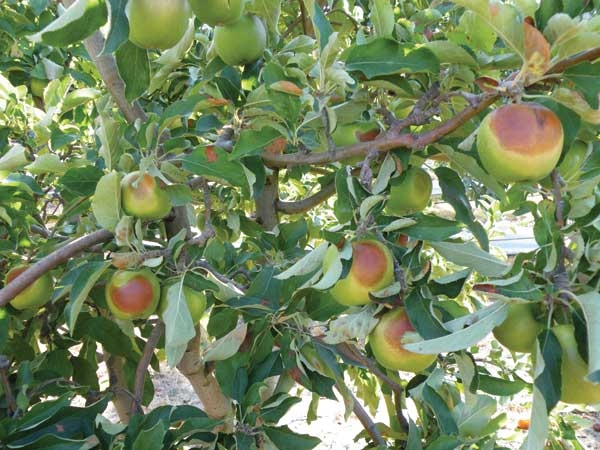The extreme heat a couple of seasons ago—and the heavy fruit losses that resulted—should not be forgotten because now is the time to protect fruit from such damage.
The last 12 months of mild temperatures and plenty of rain is a stark contrast to the 2008–09 and 2009–10 seasons where we experienced low rainfall and extreme temperatures resulting in significant levels of sunburnt fruit.
There was very little requirement for sunburn protectants last season and it will be interesting to see what this summer brings.
Lessons learnt from the 2008 to 2010 seasons
- Trees near headlands were often most affected.
- Fuji and Granny Smith appeared to be the most severely damaged varieties. Gala and Pink Lady™ were less affected.
- Fruit on the west side of trees was damaged more by sunburn than on the east side.
- Unconditioned fruit suddenly exposed to the sun’s heat were at high risk of solar radiation injury. Summer pruning, late hand thinning and the removal of sunburnt fruit resulted in previously protected fruit becoming sunburnt.
- Blocks with a healthy inter-row, as a opposed to dead grass, did better.
- Hail netting was helpful in reducing damage to fruit by solar radiation but hail netting alone was often not enough to prevent sunburn.
- Fruit that suffered the least amount of sunburn had sunburn products applied at regular intervals in addition to being covered by hail net.
- Dwarfing rootstocks provide even light distribution through the canopy, but they increase the risk of sun damage to fruit cells under extreme weather conditions.
- Weather conditions that favour fruit injury to sunburn include cool weather prior to high temperatures in combination with low humidity for extended periods of time.
Sunburn products
There is no new product of note: Parasol, Surround and Raynox are still the main sunburn protection products.
Parasol is an easy to use liquid that leaves a fine protective particle film on the surface of fruit that is removed easily in the packhouse.
Surround is a fine white powder that also leaves a protective particle film on the fruit surface. Some orchardists have had success using the spreader Du-Wett to improve coverage.
Raynox is a liquid which leaves no visible residue on fruit and does not wash off in wet weather like the other products. So it has a better fit for use in conjunction with evaporative cooling systems.
Timing
Correct application timing is essential to optimise protection. Timing applications with the fruit growth-rate curve has given the best results—apply more applications early in the season when fruit growth rate is highest, and less frequently approaching harvest.
Spray application
Applying sunburn products from above is the preferred method, rather than attempting to apply them through a traditional airblast sprayer.
Good options include tower sprayers, or attaching a boom to airblast sprayers that extends to the height of the trees.
For more information, see Tree Fruit Dec 2012




















